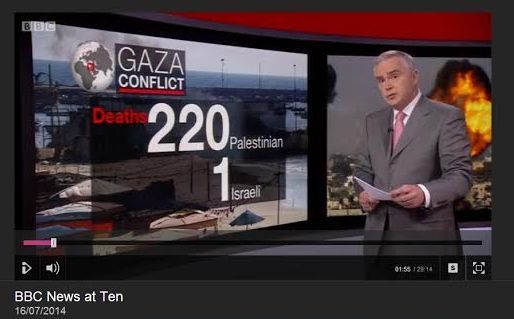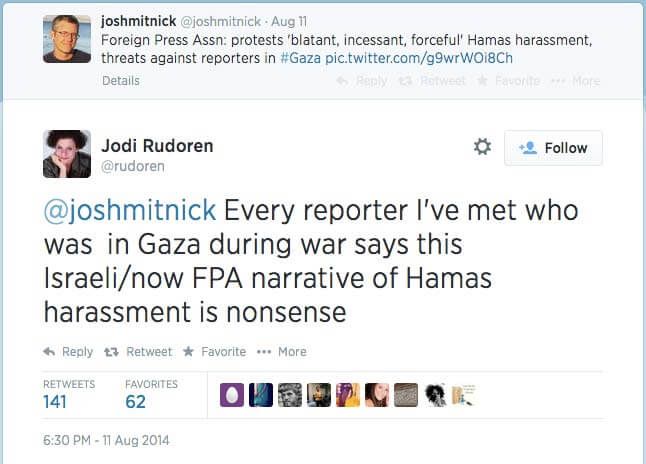Reporting during wartime may be the ultimate challenge for the media. But the conflict between Israel and Hamas revealed, yet again, the severe limitations of traditional journalism.
Five media fails stand out in particular. The biggest threats to accuracy and understanding came not from individual pieces of biased reporting but from the mass of articles that adhered to the flawed standards of journalism today.
1. Casualty Figures as Moral Barometer
Benjamin Disraeli said there are three kinds of lies: lies, damned lies, and statistics. Casualty figures cited in virtually all reports on the Gaza war served as all three. The numbers are unreliable, the true percentage of civilians unknown, and their meaning obscured by a lack of context.
Reporters often relied on figures provided by the Hamas-run Gazan Health Ministry even though Hamas has a strategic interest in inflating the numbers.
Reuven Ehrilch of the Meir Amit Intelligence and Information Center told The Media Line that his organization checked 152 names supplied by the “Gaza government’s Ministry of Health”:
The list was done hastily and later changes were made. There were a number of false names listed; the details of the dead are only partial, making identification suspicious. There are names used more than once and some might have been killed by their own fire rather than by the Israeli army. The list doesn’t differentiate between civilians and terror operatives. All the dead are listed as “shahids” [martyrs].
To make sense of the numbers, media outlets often included the percentage of those killed considered to be civilians. The number often ran as high as 80%, according to media reports.
But as the New York Times noted when it took a deeper look at the figures, a suspiciously high number of people killed were males between the ages of 20 and 29, the primary age of Hamas terrorists involved in the fighting.
“At the same time, women and children under 15, the least likely to be legitimate targets, were the most underrepresented, making up 71 percent of the population and 33 percent of the known-age casualties,” the report stated.
Another element of distortion was the presentation of the Palestinian numbers alongside the Israeli numbers, which were much lower, as though there was a relationship between the figures, like a scoreboard at a sporting event.
These numbers, however, had moral undertones, implying either that Israel was the aggressor because it killed so many more Palestinians, or that the threat against Israel was not so serious, since so few Israelis were killed.
But that doesn’t tell the real story. It does not reveal the efforts Israel has made to protect its civilians, and it doesn’t take into account the ways Hamas endangers civilians by turning residential neighborhoods into battle zones.
As Bret Stephens wrote in the Wall Street Journal:
The real utility of the body count is that it offers reporters and commentators who cite it the chance to ascribe implicit blame to Israel while evading questions about ultimate responsibility for the killing.
Presented as raw numbers, the casualty figures obscure more than they reveal.
2. The ‘Battered Journalist’ Syndrome
Covering Gaza poses challenges for any reporters, not least of which is the ever-present pressure from Hamas to adhere to the Palestinian narrative. Even reporters who never encountered direct threats knew they were operating on territory that offered no protection for free speech.
And if their livelihood depended on being able to access Gaza in the future, they knew that reporting facts that Hamas would find objectionable would risk deportation or blacklisting, at the very least.
The situation was severe enough that the Foreign Press Association (FPA) issued a scathing condemnation of Hamas’s behavior towards journalists, citing a number of examples that had emerged during the weeks of fighting.
Even Hamas admitted it intimidated reporters:
Some of the journalists who entered the Gaza Strip were under security surveillance. Even under these difficult circumstances, we managed to reach them, and tell them that what they were doing was anything but professional journalism and that it was immoral.
Yet amazingly, the response from some of the most influential journalists covering Gaza was that the entire issue was over-blown. New York Times Jerusalem Bureau Chief Jodi Rudoren even called the FPA statement “nonsense” in a tweet.
Why go out of the way to downplay something that had an obvious impact on the stories that emerged from the conflict?
Maybe if reporters were completely transparent about the challenges they faced, it would point to the fact that they should not have been reporting from Gaza in the first place.
As journalist Michael Totten wrote following the publication of the FPA’s statement:
The Gaza war was a huge story, of course, and it had to be covered, but it could just as easily have been covered from the Israeli side of the line. Covering both sides of the story is of course preferable whenever possible, but providing balanced coverage from Israel alongside censored coverage from Gaza is a form of journalistic malpractice. Stop it.
3. Failure to Disclose Missing Information
While many journalists insisted that their work was unhindered by Hamas, they could not explain credibly why there were noticeable gaps in their coverage. Most prominently missing, of course, were pictures of Hamas fighters in action.
When the issue was raised to the New York Times, the response was even more galling than the gap – the paper simply didn’t have any photos to publish. The paper’s star photographer Tyler Hicks went even further:
If we had access to them [Hamas fighters], we would be photographing them. I never saw a single device for launching the rockets to Israel. It’s as if they don’t exist.
Hicks explained that the Hamas terrorists were fighting from the margins, and if they ventured into public areas, they would immediately become targets for Israeli strikes.
Fair enough. Hamas fighters were hard to find. But there was no shortage of photos of Palestinians reacting to Israeli airstrikes or attending funerals. Maybe if the photographers had ventured out to the margins themselves, they may have spotted something.
And maybe those who did were stopped by Hamas.
The media, however, treated the issue exactly as Hicks said – as if rocket launchers and the people firing them didn’t exist. In photo gallery after photo gallery of Gaza, there was hardly any way to tell that there were two sides fighting, and not just one. Media outlets have an obligation to let the readers know what’s missing.
And if they couldn’t show it with pictures, they could have done more to explain that Hamas routinely fired from populated areas.
Of course, as the fighting started to die down, pictures and videos of rocket launch sites began to emerge, raising questions about whether the photos really were impossible to obtain or if Hamas threats were responsible for their absence.
4. Over-Emphasis on Grisly War Photos
While there were virtually no pictures of Hamas fighters during the days of heavy fighting in Gaza, there was no shortage of pictures of children or babies hurt in Israeli airstrikes.
Those pictures were particularly prevalent across the UK and other European cities and helped inflame the streets of Europe and beyond, where anti-Semitic sentiment ran to a fever pitch.
They also badly misrepresented the fighting taking place in the Gaza Strip. Taken together with the absence of photos of Hamas fighters and the message is clear: Israel is an aggressor that targets children.
5. Failure to State Hamas’s Real Goals
Throughout the weeks of fighting, and especially during the periods of negotiations for a cease-fire, the media claimed that Hamas’s main motivation was to ease the blockade around Gaza or to open a port or airport.
But does that really explain why Hamas spent the past several years building a complex of tunnels and bunkers that reached across the border and into Israel?
Does it explain why the terror group chose to smuggle or manufacture thousands, if not tens of thousands, of rockets capable of reaching the heart of Israel? Or why it continues to fire them at Israeli civilians?
Is it really looking for peace with Israel, or an easing of Israel’s security measures just to improve the lot of the people of Gaza?
It would be more honest to point out that Hamas is working toward’s Israel’s annihilation. It even has a charter that says so clearly.
As S.E. Cupp wrote in the New York Daily News:
Rarely is it mentioned in a news report that Hamas’ primary objective, its main goal, what it really wants and what its military arm is designed and determined to get, is the total destruction of Israel and the annihilation of the Jews.
It’s a crucial component that’s regularly left out of news reports. But any story that does not mention this among Hamas’ chief demands is not an intellectually honest or complete one.
Few in the media seem to grasp this, the effect of which has been to create a gauzy and nebulous moral equivalency between Israel and Hamas that isn’t really there.
Allowing Hamas to maintain its charter but ignoring it and letting the terror group present itself as a moderate force seeking the best for the people of Gaza distorts the reality.
The media has an obligation to present the conflict as it is – the aggression of a terrorist group working for the destruction of Israel and Israel’s efforts to defend its citizens. A framework that puts Israel and Hamas on an equal moral plane is another case of journalistic malpractice.
If you agree that the media failed in its duty to inform the public accurately about the Gaza conflict, please help us raise awareness by sharing this article on Facebook, Twitter, or any other social network. Sharing our material helps HonestReporting reach the widest possible audience.



